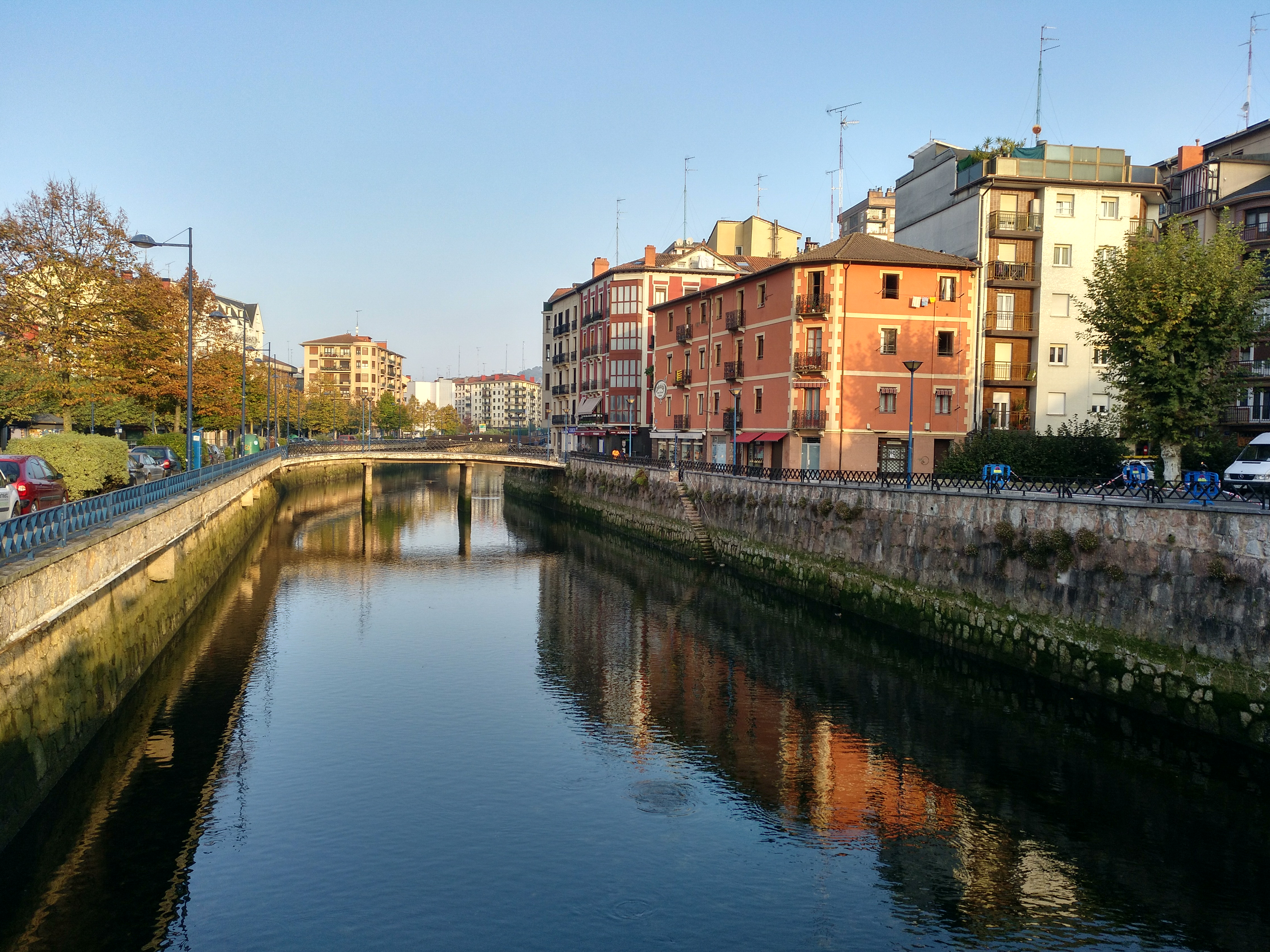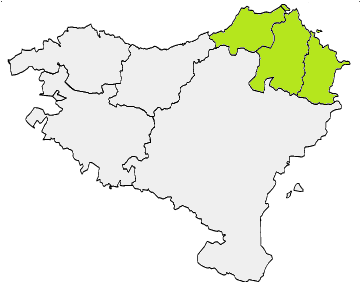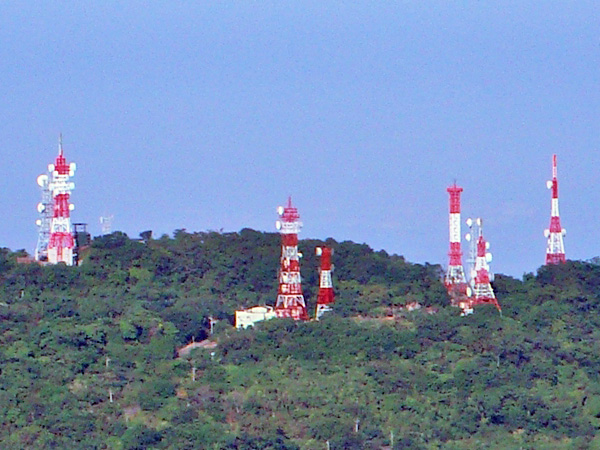|
ETB 2
ETB 2 is the second television channel from the Euskal Irrati Telebista group in the Basque Autonomous Community, Navarre and the French Basque Country. The channel broadcasts entirely in Spanish. The channel launched on 31 May 1986. A HD feed of ETB 2 was launched on 21 December 2016. Its reception area comprises the whole Basque Country — i.e. the Basque Autonomous Community, Navarre and the Northern Basque Country The French Basque Country, or Northern Basque Country ( eu, Iparralde (), french: Pays basque, es, País Vasco francés) is a region lying on the west of the French department of the Pyrénées-Atlantiques. Since 1 January 2017, it constitu ... — and some surrounding places. History The channel launched on 31 May 1986, during the first period the channel broadcast in a situation of illegality because all the procedures for its installation were carried out in secret and without the authorization of the national government. After the launch of ETB 2, E ... [...More Info...] [...Related Items...] OR: [Wikipedia] [Google] [Baidu] |
1080i
1080i (also known as Full HD or BT.709) is a combination of frame resolution and scan type. 1080i is used in high-definition television (HDTV) and high-definition video. The number "1080" refers to the number of horizontal lines on the screen. The "i" is an abbreviation for "interlaced"; this indicates that only the even lines, then the odd lines of each frame (each image called a video field) are drawn alternately, so that only half the number of actual image frames are used to produce video. A related display resolution is 1080p, which also has 1080 lines of resolution; the "p" refers to progressive scan, which indicates that the lines of resolution for each frame are "drawn" on the screen in sequence. The term assumes a widescreen aspect ratio of 16:9 (a rectangular TV that is wider than it is tall), so the 1080 lines of vertical resolution implies 1920 columns of horizontal resolution, or 1920 pixels × 1080 lines. A 1920 pixels × 1080 lines screen has a total of 2.1 ... [...More Info...] [...Related Items...] OR: [Wikipedia] [Google] [Baidu] |
Navarre
Navarre (; es, Navarra ; eu, Nafarroa ), officially the Chartered Community of Navarre ( es, Comunidad Foral de Navarra, links=no ; eu, Nafarroako Foru Komunitatea, links=no ), is a foral autonomous community and province in northern Spain, bordering the Basque Autonomous Community, La Rioja, and Aragon in Spain and Nouvelle-Aquitaine in France. The capital city is Pamplona ( eu, Iruña). The present-day province makes up the majority of the territory of the medieval Kingdom of Navarre, a long-standing Pyrenean kingdom that occupied lands on both sides of the western Pyrenees, with its northernmost part, Lower Navarre, located in the southwest corner of France. Navarre is in the transition zone between Green Spain and semi-arid interior areas, and thus its landscapes vary widely across the region. Being in a transition zone also produces a highly variable climate, with summers that are a mix of cooler spells and heat waves, and winters that are mild for the latitude. Navarr ... [...More Info...] [...Related Items...] OR: [Wikipedia] [Google] [Baidu] |
Television Stations In Spain
Television, sometimes shortened to TV, is a telecommunication medium for transmitting moving images and sound. The term can refer to a television set, or the medium of television transmission. Television is a mass medium for advertising, entertainment, news, and sports. Television became available in crude experimental forms in the late 1920s, but only after several years of further development was the new technology marketed to consumers. After World War II, an improved form of black-and-white television broadcasting became popular in the United Kingdom and the United States, and television sets became commonplace in homes, businesses, and institutions. During the 1950s, television was the primary medium for influencing public opinion.Diggs-Brown, Barbara (2011''Strategic Public Relations: Audience Focused Practice''p. 48 In the mid-1960s, color broadcasting was introduced in the U.S. and most other developed countries. The availability of various types of archival stora ... [...More Info...] [...Related Items...] OR: [Wikipedia] [Google] [Baidu] |
Northern Basque Country
The French Basque Country, or Northern Basque Country ( eu, Iparralde (), french: Pays basque, es, País Vasco francés) is a region lying on the west of the French department of the Pyrénées-Atlantiques. Since 1 January 2017, it constitutes the Basque Municipal Community ( eu, Euskal Hirigune Elkargoa, links=no; french: Communauté d'Agglomeration du Pays Basque, links=no) presided over by . It includes three former historic French provinces in the north-east of the traditional Basque Country totalling : Lower Navarre (french: Basse-Navarre, links=no; eu, Nafarroa Beherea, links=no), until 1789 nominally Kingdom of Navarre, with ; Labourd (), with ; Soule (), with . The population included in the Basque Municipal Community amounts to 309,723 inhabitants distributed in 158 municipalities. It is delimited in the north by the department of Landes, in the west by the Bay of Biscay, in the south by the Southern Basque Country and in the east by Béarn (although in the B ... [...More Info...] [...Related Items...] OR: [Wikipedia] [Google] [Baidu] |
Castilian Language
In English, Castilian Spanish can mean the variety of Peninsular Spanish spoken in northern and central Spain, the standard form of Spanish, or Spanish from Spain in general. In Spanish, the term (Castilian) can either refer to the Spanish language as a whole, or to the medieval Old Spanish, a predecessor to Early Modern Spanish. Terminology The term ''Castilian Spanish'' is used in English for the specific varieties of Spanish spoken in north and central Spain. This is because much of the variation in Peninsular Spanish is between north and south, often imagined as Castilian versus Andalusian. Typically, it is more loosely used to denote the Spanish spoken in all of Spain as compared to Spanish spoken in Latin America. In Spain itself, Spanish is not a uniform language and there exist several different varieties of Spanish; in addition, there are other official and unofficial languages in the country, although Spanish is official throughout Spain. ''Castellano septentrional' ... [...More Info...] [...Related Items...] OR: [Wikipedia] [Google] [Baidu] |
Basque Autonomous Community
The Basque Country (; eu, Euskadi ; es, País Vasco ), also called Basque Autonomous Community ( eu, Euskal Autonomia Erkidegoa, links=no, EAE; es, Comunidad Autónoma del País Vasco, links=no, CAPV), is an autonomous community of Spain. It includes the provinces (and historical territories) of Álava, Biscay, and Gipuzkoa, located in the north of the Iberian Peninsula, bordering on the autonomous communities of Cantabria, Castile and León, La Rioja, and Navarre, and the French region of Nouvelle-Aquitaine. The Basque Country or Basque Autonomous Community is enshrined as a 'nationality' within the Spanish State in its 1979 statute of autonomy, pursuant to the administrative acquis laid out in the 1978 Spanish Constitution. The statute provides the legal framework for the development of the Basque people on Spanish soil. Navarre, which had narrowly rejected a joint statute with Gipuzkoa, Álava and Biscay in 1932, became a full-fledged foral autonomous community in 1982. ... [...More Info...] [...Related Items...] OR: [Wikipedia] [Google] [Baidu] |
Gipuzkoa
Gipuzkoa (, , ; es, Guipúzcoa ; french: Guipuscoa) is a province of Spain and a historical territory of the autonomous community of the Basque Country. Its capital city is Donostia-San Sebastián. Gipuzkoa shares borders with the French department of Pyrénées-Atlantiques at the northeast, with the province and autonomous community of Navarre at east, Biscay at west, Álava at southwest and the Bay of Biscay to its north. It is located at the easternmost extreme of the Cantabric Sea, in the Bay of Biscay. It has of coast land. With a total area of , Gipuzkoa is the smallest province of Spain. The province has 89 municipalities and a population of 720,592 inhabitants (2018), from which more than half live in the Donostia-San Sebastián metropolitan area. Apart from the capital, other important cities are Irun, Errenteria, Zarautz, Mondragón, Eibar, Hondarribia, Oñati, Tolosa, Beasain and Pasaia. The oceanic climate gives the province an intense green colour with littl ... [...More Info...] [...Related Items...] OR: [Wikipedia] [Google] [Baidu] |
French Basque Country
The French Basque Country, or Northern Basque Country ( eu, Iparralde (), french: Pays basque, es, País Vasco francés) is a region lying on the west of the French department of the Pyrénées-Atlantiques. Since 1 January 2017, it constitutes the Basque Municipal Community ( eu, Euskal Hirigune Elkargoa, links=no; french: Communauté d'Agglomeration du Pays Basque, links=no) presided over by . It includes three former historic French provinces in the north-east of the traditional Basque Country totalling : Lower Navarre (french: Basse-Navarre, links=no; eu, Nafarroa Beherea, links=no), until 1789 nominally Kingdom of Navarre, with ; Labourd (), with ; Soule (), with . The population included in the Basque Municipal Community amounts to 309,723 inhabitants distributed in 158 municipalities. It is delimited in the north by the department of Landes, in the west by the Bay of Biscay, in the south by the Southern Basque Country and in the east by Béarn (although in the ... [...More Info...] [...Related Items...] OR: [Wikipedia] [Google] [Baidu] |
Biscay
Biscay (; eu, Bizkaia ; es, Vizcaya ) is a province of Spain and a historical territory of the Basque Country, heir of the ancient Lordship of Biscay, lying on the south shore of the eponymous bay. The capital and largest city is Bilbao. Biscay is one of the most renowned and prosperous provinces of Spain, historically a major trading hub in the Atlantic Ocean since medieval times and, later on, one of the largest industrial and financial centers of the Iberian peninsula. Since the extensive deindustrialization that took place throughout the 1970s, the economy has come to rely more on the services sector. Etymology It is accepted in linguistics (Koldo Mitxelena, etc.) that ''Bizkaia'' is a cognate of ''bizkar'' (cf. Biscarrosse in Aquitaine), with both place-name variants well attested in the whole Basque Country and out meaning 'low ridge' or 'prominence' (''Iheldo bizchaya'' attested in 1141 for the Monte Igueldo in San Sebastián). Denominations ''Bizkaia'' ''Bi ... [...More Info...] [...Related Items...] OR: [Wikipedia] [Google] [Baidu] |
Álava
Álava ( in Spanish) or Araba (), officially Araba/Álava, is a province of Spain and a historical territory of the Basque Country, heir of the ancient Lordship of Álava, former medieval Catholic bishopric and now Latin titular see. Its capital city, Vitoria-Gasteiz, is also the seat of the political main institutions of the Basque Autonomous Community. It borders the Basque provinces of Biscay and Gipuzkoa to the north, the community of La Rioja to the south, the province of Burgos (in the community of Castile and León) to the west and the community of Navarre to the east. The Enclave of Treviño, surrounded by Alavese territory, is however part of the province of Burgos, thus belonging to the autonomous community of Castile and León, not Álava. It is the largest of the three provinces in the Basque Autonomous Community in geographical terms, with 2,963 km2, but also the least populated with 331,700 inhabitants (2019). Etymology Built around the Roman mansion Alba ... [...More Info...] [...Related Items...] OR: [Wikipedia] [Google] [Baidu] |
Digital Terrestrial Television
Digital terrestrial television (DTTV or DTT, or DTTB with "broadcasting") is a technology for terrestrial television in which land-based (terrestrial) television stations broadcast television content by radio waves to televisions in consumers' residences in a digital format. DTTV is a major technological advance over the previous analog television, and has largely replaced analog which had been in common use since the middle of the 20th century. Test broadcasts began in 1998 with the changeover to DTTV (aka Analog Switchoff (ASO), or Digital Switchover (DSO)) beginning in 2006 and is now complete in many countries. The advantages of ''digital'' terrestrial television are similar to those obtained by digitising platforms such as cable TV, satellite, and telecommunications: more efficient use of limited radio spectrum bandwidth, provision of more television channels than analog, better quality images, and potentially lower operating costs for broadcasters (after the initial up ... [...More Info...] [...Related Items...] OR: [Wikipedia] [Google] [Baidu] |
Canal Vasco
{{Infobox television channel , name = Canal Vasco , logo = Logo canal vasco.png , logo_size = 220px , launch_date = {{Start date and age, 1996, 6, 3, df=y , network = ETB , owner = EiTB , country = Spain , language = Basque and Spanish , area = Americas Worldwide , affiliates = , headquarters = Bilbao, Basque Country , replaced = , replaced_by = , sister_channels = ETB 1ETB 2ETB 3 ETB 4 ETB Sat , timeshift_service = , website eitb.eus/en, digital = , terr_serv_1 = , terr_chan_1 = , terr_chan_2 = , terr_chan_3 = , terr_chan_4 = , sat_radio_serv_1 = , sat_radio_chan_1 = , adsl serv 1 = , adsl chan 1 = , adsl serv 2 = , adsl chan 2 = , adsl serv 3 = , adsl chan 3 = , online_serv_1 eitb.eus, online_chan_1 Live streaming, ... [...More Info...] [...Related Items...] OR: [Wikipedia] [Google] [Baidu] |



